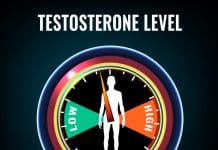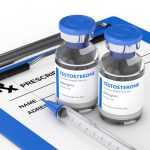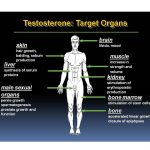Testosterone production, action, and clinical manifestations of testosterone deficiency.In the male body, the hypothalamus secretes gonadotropin-releasing hormone, or GNRH in a pulsatile fashion to stimulate the release of follicle-stimulating hormone, or FSH and luteinizing hormone or LH from the pituitary gland. LH travels in the bloodstream to the leydig cells of the testes, where it binds to the LH receptor and initiates a series of biochemical events that convert low-density lipoprotein or LDL cholesterol to testosterone. Testosterone secreted from the testes is carried by the bloodstream to target tissues where it produces its biological effects.
Failure of the testes to make physiological levels of testosterone is called hypogonadism. Hypogonadism due to abnormalities of the testes themselves is called primary hypogonadism, whereas a defect in the hypothalamic pituitary axis is termed secondary hypogonadism. Dual or mixed forms can also occur. If an insufficient amount of testosterone reaches the target tissues, manifestations of testosterone deficiency may appear in liver, muscle and adipose tissue. Testosterone binds directly to the androgen receptor. In the liver, testosterone enhances protein synthesis while in muscle, testosterone enhances muscle mass. Given its role in muscle, men with reduced levels of testosterone may complain of muscle weakness, lethargy or decreased energy.
In other tissues, testosterone must first undergo conversion before becoming biologically active. In the brain and bone, testosterone is converted by aromatization to estradiol, which then binds the estrogen receptor. Testosterone enhances bone development by promoting bone accretion. Men with reduced testosterone levels may develop osteoporosis. Testosterone acts in the brain to stabilize mood, enhance libido and may even have a positive effect on cognition. As a result, men with testosterone deficiency can experience mood changes, a lack of motivation, and reduced libido. To bind to the androgen receptor on skin, hair, gonadal and prostate tissues, testosterone is converted by 5-ᾳ-reductase to dihydrotestosterone, or DHT. Testosterone supports the growth of facial, body, axillary and pubic hair in the adult.
However, in some genetically susceptible men, testosterone may also inhibit hair growth in some areas of the scalp, leading to baldness. In the sexual organs, testosterone contributes to penile growth, spermatogenesis and prostate growth and function. Profound hypogonadism interferes with the vascular function of the penis, or corpora, and may lead to erectile dysfunction, and a decrease in orgasm quality. Other effects of testosterone include promotion of erythropoiesis and regulation of immune function. In summary, testosterone production plays a key role in many body tissues and testosterone deficiency can result in a myriad of clinical manifestations.
Recent Posts
Most Informative Articles on Testosterone, ED, Trimix, HCG and More on ExcelMale.com
Most Informative Articles on Testosterone, ED, Trimix, HCG and More on ExcelMale.com
Affordable Lab Tests- No prescription Required- Most US Cities
How to Use ExcelMale.com For...
Penile Implants- Interview with Dr. Robert Cornell in Houston
Q & A with Robert J. Cornell, M.D. – Prosthetic Urology and Men’s Health Specialist
Robert J. Cornell, MD specializes in the treatment of genitourinary...
Anabolic Resistance: Why It Is Harder To Add Muscle Mass As We Age and...
We lose muscle mass and strength as we age. This is known as sarcopenia.
Muscle loss could begin in our 30s. Genetics and lifestyle play...
How to Inject Testosterone Safely
In this video the folks from Defy Medical show how to safely inject testosterone in the glutes.
The following information was taken from the book:...
Testosterone Therapeutic Options and Best Practices
Transcript:
Testosterone Therapeutic Options and Best Practices
This excellent lecture is recommended for clinicians and educated patients.
From largest urology conference in the world (2015)
Lecture Video
TRANSCRIPTION:
Speaker 1:...

















